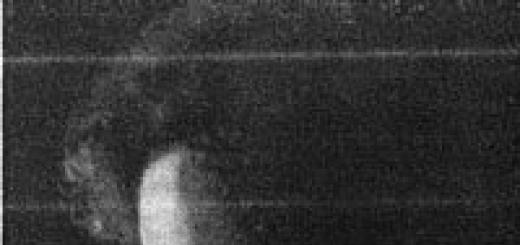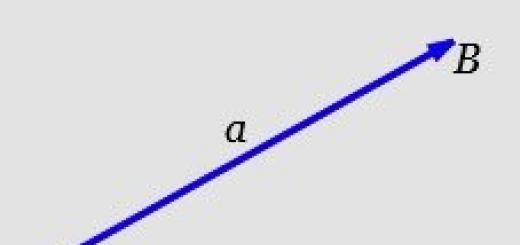When studying various branches of physics, mechanics and technical sciences, quantities are encountered that are completely determined by specifying their numerical values. Such quantities are called scalar or, in short, scalars.
Scalar quantities are length, area, volume, mass, body temperature, etc. In addition to scalar quantities, in various problems there are quantities for which, in addition to their numerical value, it is also necessary to know their direction. Such quantities are called vector. Physical examples of vector quantities can be the displacement of a material point moving in space, the speed and acceleration of this point, as well as the force acting on it.
Vector quantities are represented using vectors.
Vector definition. A vector is a directed segment of a straight line that has a certain length.
A vector is characterized by two points. One point is the beginning point of the vector, the other point is the end point of the vector. If we denote the beginning of the vector with a dot A , and the end of the vector is a point IN , then the vector itself is denoted . A vector can also be denoted by one small Latin letter with a bar over it (for example, ).
Graphically, a vector is denoted by a segment with an arrow at the end.
The beginning of the vector is called its point of application. If the point A is the beginning of the vector , then we will say that the vector is applied at the point A.
A vector is characterized by two quantities: length and direction.
Vector length – the distance between the starting point A and the end point B. Another name for the length of a vector is the modulus of the vector and is indicated by the symbol . The vector modulus is denoted Vector , whose length is 1 is called a unit vector. That is, the condition for the unit vector
A vector with zero length is called a zero vector (denoted by ). Obviously, the zero vector has the same beginning and end points. The zero vector has no specific direction.
Definition of collinear vectors. Vectors and located on the same line or on parallel lines are called collinear .
Note that collinear vectors can have different lengths and different directions.
Determination of equal vectors. Two vectors are said to be equal if they are collinear, have the same length and the same direction.
In this case they write:
Comment. From the definition of equality of vectors it follows that a vector can be transferred in parallel by placing its origin at any point in space (in particular, a plane).
All zero vectors are considered equal.
Determination of opposite vectors. Two vectors are called opposite if they are collinear, have the same length, but the opposite direction.
In this case they write:
In other words, the vector opposite to the vector is denoted as .
A vector is a directed segment of a straight line in Euclidean space, one end of which (point A) is called the beginning of the vector, and the other end (point B) the end of the vector (Fig. 1). Vectors are designated:

If the beginning and end of the vector coincide, then the vector is called zero vector and is designated 0 .
Example. Let the beginning of the vector in two-dimensional space have coordinates A(12.6) , and the end of the vector is the coordinates B(12.6). Then the vector is the zero vector.
Section length AB called module (length, the norm) vector and is denoted by | a|. A vector of length equal to one is called unit vector. In addition to the module, the vector is characterized by direction: the vector has a direction from A To B. A vector is called a vector, opposite vector.

The two vectors are called collinear, if they lie on the same line or on parallel lines. In the picture Fig. The 3 red vectors are collinear, because they lie on the same straight line, and the blue vectors are collinear, because they lie on parallel lines. Two collinear vectors are called equally directed, if their ends lie on the same side of the straight line connecting their beginnings. Two collinear vectors are called oppositely directed, if their ends lie on opposite sides of the straight line connecting their beginnings. If two collinear vectors lie on the same straight line, then they are called identically directed if one of the rays formed by one vector completely contains the ray formed by the other vector. Otherwise, the vectors are said to be oppositely directed. In Figure 3, the blue vectors are equally directed, and the red vectors are oppositely directed.

The two vectors are called equal if they have equal modules and the same directions. In Figure 2, the vectors are equal because their modules are equal and have the same direction.
The vectors are called coplanar, if they lie on the same plane or in parallel planes.
IN n In a dimensional vector space, consider the set of all vectors whose starting point coincides with the origin of coordinates. Then the vector can be written in the following form:
| (1) |
Where x 1 , x 2 , ..., x n vector end point coordinates x.
A vector written in the form (1) is called row vector, and the vector written in the form
| (2) |
called column vector.
Number n called dimension (in order) vector. If ![]() then the vector is called zero vector(since the starting point of the vector
then the vector is called zero vector(since the starting point of the vector ![]() ). Two vectors x And y are equal if and only if their corresponding elements are equal.
). Two vectors x And y are equal if and only if their corresponding elements are equal.
Page 1 of 2
Question 1. What is a vector? How are vectors designated?
Answer. We will call a directed segment a vector (Fig. 211). The direction of a vector is determined by indicating its beginning and end. In the drawing, the direction of the vector is indicated by an arrow. To denote vectors we will use lowercase Latin letters a, b, c, .... You can also denote a vector by indicating its beginning and end. In this case, the beginning of the vector is placed in first place. Instead of the word “vector,” an arrow or a line is sometimes placed above the letter designation of the vector. The vector in Figure 211 can be denoted as follows:
\(\overline(a)\), \(\overrightarrow(a)\) or \(\overline(AB)\), \(\overrightarrow(AB)\).
Question 2. What vectors are called identically directed (oppositely directed)?
Answer. Vectors \(\overline(AB)\) and \(\overline(CD)\) are said to be equally directed if the half-lines AB and CD are equally directed.
Vectors \(\overline(AB)\) and \(\overline(CD)\) are said to be oppositely directed if the half-lines AB and CD are oppositely directed.
In Figure 212, the vectors \(\overline(a)\) and \(\overline(b)\) are equally directed, and the vectors \(\overline(a)\) and \(\overline(c)\) are oppositely directed.

Question 3. What is the absolute magnitude of a vector?
Answer. The absolute value (or modulus) of a vector is the length of the segment representing the vector. The absolute value of the vector \(\overline(a)\) is denoted by |\(\overline(a)\)|.
Question 4. What is a null vector?
Answer. The beginning of a vector can coincide with its end. We will call such a vector the zero vector. The zero vector is denoted by a zero with a dash (\(\overline(0)\)). They don't talk about the direction of the zero vector. The absolute value of the zero vector is considered equal to zero.
Question 5. What vectors are called equal?
Answer. Two vectors are said to be equal if they are combined by parallel translation. This means that there is a parallel translation that takes the start and end of one vector to the start and end of another vector, respectively.
Question 6. Prove that equal vectors have the same direction and are equal in absolute value. And vice versa: identically directed vectors that are equal in absolute value are equal.
Answer. During parallel translation, the vector retains its direction, as well as its absolute value. This means that equal vectors have the same directions and are equal in absolute value.
Let \(\overline(AB)\) and \(\overline(CD)\) be identically directed vectors, equal in absolute value (Fig. 213). A parallel translation that moves point C to point A combines the half-line CD with the half-line AB, since they have the same direction. And since the segments AB and CD are equal, then point D coincides with point B, i.e. parallel translation transforms the vector \(\overline(CD)\) into the vector \(\overline(AB)\). This means that the vectors \(\overline(AB)\) and \(\overline(CD)\) are equal, which is what needed to be proved.

Question 7. Prove that from any point you can plot a vector equal to a given vector, and only one.
Answer. Let CD be a line, and the vector \(\overline(CD)\) be part of the line CD. Let AB be the straight line into which the straight line CD goes during parallel transfer, \(\overline(AB)\) be the vector into which the vector \(\overline(CD)\) goes during parallel transfer, and therefore the vectors \(\ overline(AB)\) and \(\overline(CD)\) are equal, and straight lines AB and CD are parallel (see Fig. 213). As we know, through a point not lying on a given line, it is possible to draw on the plane at most one straight line parallel to the given one (axiom of parallel lines). This means that through point A one line can be drawn parallel to line CD. Since the vector \(\overline(AB)\) is part of the line AB, then through point A one can draw one vector \(\overline(AB)\), equal to the vector \(\overline(CD)\).
Question 8. What are vector coordinates? What is the absolute value of the vector with coordinates a 1, a 2?
Answer. Let the vector \(\overline(a)\) have a beginning point A 1 (x 1 ; y 1), and an end point A 2 (x 2 ; y 2). The coordinates of the vector \(\overline(a)\) will be the numbers a 1 = x 2 - x 1 , a 2 = y 2 - y 1 . We will put the coordinates of the vector next to the letter designation of the vector, in this case \(\overline(a)\) (a 1 ; a 2) or simply \((\overline(a 1 ; a 2 ))\). The coordinates of the zero vector are equal to zero.
From the formula expressing the distance between two points through their coordinates, it follows that the absolute value of the vector with coordinates a 1 , a 2 is equal to \(\sqrt(a^2 1 + a^2 2 )\).
Question 9. Prove that equal vectors have respectively equal coordinates, and vectors with respectively equal coordinates are equal.
Answer. Let A 1 (x 1 ; y 1) and A 2 (x 2 ; y 2) be the beginning and end of the vector \(\overline(a)\). Since the vector \(\overline(a)\) equal to it is obtained from the vector \(\overline(a)\) by parallel translation, its beginning and end will be A" 1 (x 1 + c; y 1 + d) respectively ), A" 2 (x 2 + c; y 2 + d). This shows that both vectors \(\overline(a)\) and \(\overline(a")\) have the same coordinates: x 2 - x 1, y 2 - y 1.
Let us now prove the converse statement. Let the corresponding coordinates of the vectors \(\overline(A 1 A 2 )\) and \(\overline(A" 1 A" 2 )\) be equal. Let us prove that the vectors are equal.
Let x" 1 and y" 1 be the coordinates of point A" 1, and x" 2, y" 2 be the coordinates of point A" 2. According to the conditions of the theorem, x 2 - x 1 = x" 2 - x" 1, y 2 - y 1 = y" 2 - y" 1. Hence x" 2 = x 2 + x" 1 - x 1, y" 2 = y 2 + y" 1 - y 1. Parallel transfer given by formulas
x" = x + x" 1 - x 1 , y" = y + y" 1 - y 1 ,
transfers point A 1 to point A" 1, and point A 2 to point A" 2, i.e. the vectors \(\overline(A 1 A 2 )\) and \(\overline(A" 1 A" 2 )\) are equal, which is what needed to be proved.
Question 10. Define the sum of vectors.
Answer. The sum of vectors \(\overline(a)\) and \(\overline(b)\) with coordinates a 1 , a 2 and b 1 , b 2 is called the vector \(\overline(c)\) with coordinates a 1 + b 1, a 2 + b a 2, i.e.
\(\overline(a) (a 1 ; a 2) + \overline(b)(b 1 ; b 2) = \overline(c) (a 1 + b 1 ; a 2 + b 2)\).










